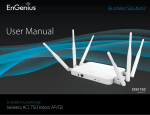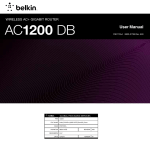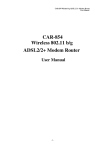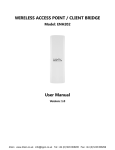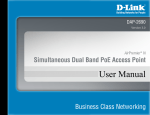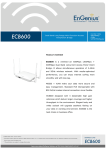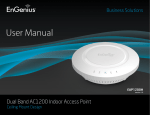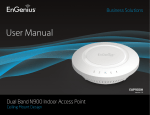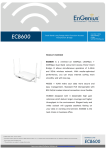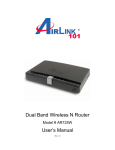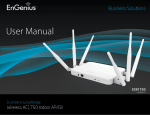Download ECB600 User Manual - EnGenius Technologies, Inc.
Transcript
1 1 Table of Contents 1 2 3 4 5 Introduction ....................................................................................................................................................................... 5 1.1 1.2 1.3 1.4 Features and Benefits .....................................................................................................................................................................................6 Package Contents ............................................................................................................................................................................................7 System Requirements.....................................................................................................................................................................................7 Applications .......................................................................................................................................................................................................8 2.1 2.2 2.3 2.4 Considerations for Wireless Installation ............................................................................................................................................... 10 Computer Settings (in Windows XP/Windows 7).............................................................................................................................. 11 Computer Settings in Apple Mac OS X................................................................................................................................................. 14 Hardware Installation................................................................................................................................................................................... 15 3.1 3.2 Default Settings ............................................................................................................................................................................................. 18 Web Configuration....................................................................................................................................................................................... 19 4.1 4.2 4.3 4.4 4.5 Access Point Mode ....................................................................................................................................................................................... 21 Client Bridge Mode ...................................................................................................................................................................................... 22 WDS AP / WDS Station Mode.................................................................................................................................................................. 23 WDS Bridge Mode........................................................................................................................................................................................ 24 Repeater mode .............................................................................................................................................................................................. 25 5.1 5.2 5.3 5.4 Save/Reload .................................................................................................................................................................................................... 26 Main ................................................................................................................................................................................................................... 27 2.4G/5G Wireless Client List ...................................................................................................................................................................... 30 2.4G/5G Connection Status....................................................................................................................................................................... 31 Before you Begin ............................................................................................................................................................. 10 Configuring Your ECB600............................................................................................................................................... 18 Building a Wireless Network ......................................................................................................................................... 21 Status ................................................................................................................................................................................ 26 2 6 7 8 5.5 5.6 2.4G/5G WDS Link List ................................................................................................................................................................................ 32 System Log ...................................................................................................................................................................................................... 33 6.1 6.2 6.3 6.4 Operation Mode............................................................................................................................................................................................ 34 IP Settings........................................................................................................................................................................................................ 36 Spanning Tree Setting................................................................................................................................................................................. 38 Band Steering ................................................................................................................................................................................................. 40 7.1 7.2 7.3 7.4 7.5 7.6 7.7 Wireless Network .......................................................................................................................................................................................... 41 Wireless Security ........................................................................................................................................................................................... 47 Site Survey ....................................................................................................................................................................................................... 51 Wireless MAC Filtering................................................................................................................................................................................ 55 Wireless Advanced Settings...................................................................................................................................................................... 57 WPS (Wi-Fi Protected Setup).................................................................................................................................................................... 60 WDS Link Settings......................................................................................................................................................................................... 62 8.1 8.2 8.3 8.4 8.5 8.6 8.7 8.8 8.9 8.10 8.11 Administration................................................................................................................................................................................................ 64 Management VLAN Settings .................................................................................................................................................................... 65 Wireless Traffic Shaping ............................................................................................................................................................................. 74 SNMP Settings ............................................................................................................................................................................................... 76 Backup/Restore.............................................................................................................................................................................................. 78 Firmware Upgrade ........................................................................................................................................................................................ 79 Time Settings.................................................................................................................................................................................................. 80 Schedule........................................................................................................................................................................................................... 81 CLI Setting ....................................................................................................................................................................................................... 83 Log...................................................................................................................................................................................................................... 84 Diagnostics...................................................................................................................................................................................................... 85 System .............................................................................................................................................................................. 34 2.4G/5G Wireless............................................................................................................................................................. 41 Management.................................................................................................................................................................... 64 3 8.12 8.13 8.14 8.15 Device Discovery ........................................................................................................................................................................................... 87 LED Control ..................................................................................................................................................................................................... 88 Logout............................................................................................................................................................................................................... 89 Reset .................................................................................................................................................................................................................. 90 Appendix A – FCC Interference Statement .......................................................................................................................... 91 Appendix B – IC Interference Statement ............................................................................................................................. 92 Appendix C – CE Interference Statement............................................................................................................................. 94 4 Revision History Version 1.0 Date 2013/03/20 Notes First Release 5 1 Introduction The ECB600 is a high-powered, long-range dual-band concurrent wireless 802.11a/b/g/n access point with six major functional modes. It is designed to operate in numerous environments from large homes, small and medium-sized businesses, multiple-floor offices, hotels and other venues to larger enterprise deployments. Its high-powered, long-range characteristics make it a cost-effective alternative to ordinary access points that don’t have the range and reach to connect to a growing number of wireless users who wish to connect to a large home or business network. The ECB600 supports IEEE 802.11b/g/n standards in the 2.4GHz frequency band while at the same time supporting IEEE 802.11a/n standards in the less congested 5GHz frequency band ideal for streaming or transferring other large files. The ECB600 delivers up to 6x faster wireless speeds and 7x extended coverage than legacy 802.11a/b/g wireless devices. Even though the ECB600 has been designed and engineered for traffic heavy and demanding business environments it is also quite at home in larger house scenarios because it efficiently extends the wireless range of an existing home router, especially in very architecturally-challenging structures to provide whole home connectivity. To protect sensitive data during wireless transmissions, the ECB600 offers different encryption settings for wireless transmissions including industry-standard WPA and WPA2 encryption. The ECB600 also includes MAC address filtering to allow network administrators to offer network access only to known computers and other devices based on their MAC addresses. 6 1.1 Features and Benefits Features Benefits High Speed Data Rate Up to 300 Mbps for each band (2.4GHz / 5GHz) Capable of handling heavy data payloads such as HD multimedia streaming. IEEE 802.11n Compliant and Backwards Compatible with 802.11 a/b/g devices Fully compatible with IEEE 802.11 a/b/g/n devices. 10/100/1000 Gigabit Ethernet Multiple Operation Modes Support Multiple SSIDs in AP mode (up to 8 in each frequency band) WPA/WPA2/IEEE 802.1x Support MAC Address Filtering in AP Mode User Isolation Support (AP mode) Power-over-Ethernet (IEEE802.3at/af) Save User Settings SNMP Remote Configuration Management QoS (WMM) support Supports up to 1000Mbps wired networking speed. Allowing users to select any one of the following modes: Access Point, Client Bridge, WDS AP, WDS Bridge, WDS Station and Repeater depending on their specific networking deployment need. Allows clients to access different networks through a single access point and assign different policies and functions for each SSID through the built-in software. Supports industry-standard wireless encryption. For more secure network connections with known users and devices. Offers an additional layer of protection within the network by isolating specific client users. Allows installers to deploy the ECB600 in locations via a PoE connection (Ethernet cable) where a power outlet may not be available. Enables network administrators to save their device settings so firmware upgrades do not permanently delete previous device settings. Allows remote connection to configure or manage the ECB600 easily. Prioritizes bandwidth-intensive and sensitive data traffic. 7 IPv6 Address support ECB600 supports IPv6, you can use IPv6 address in ECB600. Band Steering When Band Steering is activated dual-band client devices are associated to the ECB600 access point on the 5 GHz frequency band. 1.2 Package Contents The ECB600 package contains the following items (Resellers and dealers require that all items must be in package to issue a refund): ECB600 Access Point/Client Bridge RJ-45 Ethernet LAN Cable 12V/2A 100V~240V Power Adapter 2.4 GHz Detachable Antenna x 2 5 GHZ Detachable Antenna x 2 Wall Mount Screw Kit CD with User's Manual Quick Installation Guide 1.3 System Requirements The following are the Minimum System Requirements in order configure the device. Computer with an Ethernet interface or wireless network capability Web-Browsing Application (i.e.: Internet Explorer, Firefox, Safari, or other similar browser application) Windows OS (XP, Vista, 7), Mac OS X, or Linux-based operating systems 8 1.4 Applications Wireless LAN (WLAN) products are easy to install and highly efficient. The following list describes the benefits of deploying a wireless access point: a) Difficult-to-Wire Environments There are many situations where wires cannot be installed, deployed easily or cannot be hidden from view. Many older buildings sites, or areas within a building may make the installation of an Ethernet-based LAN impossible, impractical or expensive. b) Temporary Workgroups A deployed wireless access point or several access points, gives businesses the flexibility to create temporary workgroups/networks in more open areas within a building – auditoriums, amphitheater classrooms, ballrooms, arenas, exhibition centers, and temporary offices. c) The Ability to Access Real-Time Information Doctors/Nurses, Point-of-Sale Employees, and/or Warehouse Workers can access real-time information on their network via the access point while dealing with patients, serving customers, and/or processing information. d) Frequently Changing Environments Setting up an access point, like the ECB600, to provide access to a company network or its Internet connection is quick and easy which also makes it ideal for establishing network access in temporary venues like exhibits, special events, or show rooms. e) Small Office and Home Office (SOHO) Networks A wireless access point, like the ECB600, is ideal for SOHO users who need a cost-effective way to expand their existing network to provide more access for more devices, easy and quick installation of a small network. f) Wireless Extensions to Existing Ethernet-based Networks Wireless access points, like the ECB600, enable network administrators, installers and end-users to extend the range and reach of an existing Ethernet-based network. 9 g) Training/Educational Facilities Training sites at corporations and universities deploy wireless access points to provide connectivity their networks and the Internet connection for their employees and students. 10 2 Before you Begin This section will guide you through the installation process. Placement of the EnGenius ECB600 is essential to maximize the access point’s performance. Avoid placing the ECB600 in an enclosed space such as a closet, cabinet, or stairwell. 2.1 Considerations for Wireless Installation Generally, the exact operating distance of a wireless device, like the ECB600, cannot be pre-determined due to a number of unknown variables or obstacles in the environment in which the device will be deployed. These could be the number, thickness, and location of walls, ceilings, elevator shafts, stairwells, or other objects that the device's wireless signals must pass through. Here are some key guidelines to allow the ECB600 to have optimal wireless range. Keep the number of walls and/or ceilings between the ECB600 and other network devices to a minimum. Each wall Building materials make a difference. A solid metal door and/or aluminum studs may have a significant negative and/or ceiling can reduce the signal strength, resulting in lower signal strength. effect on the signal strength of the ECB600. Locate your wireless devices carefully so the signal can pass through drywall and/or open doorways. Materials such as glass, steel, metal, concrete, water (example: fish tanks), mirrors, file cabinets and/or brick can also diminish wireless signal strength. Interference from other electrical devices and/or appliances that generate RF noise can also diminish the ECB600’s signal strength. The most common types of devices are microwaves or cordless phones. 11 2.2 Computer Settings (in Windows XP/Windows 7) In order to use the ECB600, you must first configure the TCP/IPv4 connection of your Windows OS computer system. Click Start button and open Control Panel. Windows XP Windows 7 12 In Windows XP, click Network Connections In Windows 7, click View Network Status and Tasks in the Network and Internet section, then select Change Right click on Local Area Connection and select Properties adapter settings 13 Select “Internet Protocol Version 4 (TCP/IPv4)” and then Select Use the following IP address and enter an IP address that is select Properties different from the ECB600 and subnet mask then click OK. Note: Ensure that the IP address and subnet mask are on the same subnet as the device. For example: ECB600 IP address: 192.168.1.1 PC IP address: 192.168.1.2 – 192.168.1.255 PC subnet mask: 255.255.255.0 14 2.3 Computer Settings in Apple Mac OS X Go to System Preferences (can be opened in the Applications folder or selecting it in the Apple Menu) Highlight Ethernet Select Network in the Internet & Network section In Configure IPv4, select Manually Enter an IP address that is different from the ECB600 and subnet mask then press OK Note: Ensure that the IP address and subnet mask are on the same subnet as the device. For example: ECB600 IP address: 192.168.1.1 PC IP address: 192.168.1.2 – 192.168.1.255 PC subnet mask: 255.255.255.0 Click Apply when done. 15 2.4 Hardware Installation 1. Ensure that the computer in use has an available Ethernet (RJ-45) Port. For more information, verify with your computer’s user manual. 2. Connect one end of the Category 5e Ethernet cable into the RJ-45 port of the ECB600 and the other end to the RJ-45 port of the computer. Ensure that the cable is securely connected to both the ECB600 and the computer. 3. Connect the Power Adapter DC connector to the DC-IN port of the ECB600 and the Power Adapter to an available electrical outlet. Once both connections are secure, verify the following: a) b) c) d) Ensure that the POWER light is on (it will be orange). Ensure that the 2.4GHz/5GHz WLAN light is on (they will be blue). Ensure that the LAN (Computer/ECB600 Connection) light is on (it will be blue). Once all lights are on, proceed to set up the ECB600 using the computer. 16 This diagram depicts the hardware configuration. 17 Front Panel LED Lights LED lights for Power, Gigabit Ethernet port, WLAN 2.4G and WLAN 5G. Power DC IN for Power. Reset Button One click for reset the device. Press over 10 seconds for reset to factory default. Rear Panel Gigabit Ethernet Port Gigabit Ethernet port for RJ-45 cable. 18 3 Configuring Your ECB600 This section will show you how to configure the device using the web-based configuration interface. 3.1 Default Settings Please use your Ethernet port or wireless network adapter to connect the ECB600. Default Settings IP Address 192.168.1.1 Username / Password admin / admin Operation Mode AP / AP 19 3.2 Web Configuration Open a web browser (Internet Explorer/Firefox/Safari) and enter the IP Address http://192.168.1.1 The default username and password are admin. Once you have entered the correct username and password, click the Note: If you have changed the default LAN IP Address of the Access Point, ensure you enter the correct IP Address. Login button to open the web-base configuration page. 20 If successful, you will be logging in and see the ECB600 User Menu. 21 4 Building a Wireless Network The ECB600 has the ability to operate in various modes. This chapter describes the operating modes of the ECB600. 4.1 Access Point Mode In Access Point Mode, ECB600 behaves likes a central connection for stations or clients that support IEEE 802.11a/b/g/n networks. The stations and clients must be configured to use the same SSID (Service Set Identifier) and security password to associate with the ECB600. The ECB600 supports up to eight SSIDs at the same time for secure access. 22 4.2 Client Bridge Mode In Client Bridge Mode, the ECB600 essentially acts as a wireless adapter that connects to an access point to allow a system wireless access to the network. This mode requires you to connect the Ethernet port on your PC to the ECB600 LAN port. If you use the client bridge operating mode, use the ECB600 Site Survey feature to scan for Access Points within range. When you find an Access Point, configure the ECB600 to use the same SSID and Security Password as the Access Point to associate with it. 23 4.3 WDS AP / WDS Station Mode The ECB600 also supports WDS AP mode. This operating mode allows wireless connections to the ECB600 using WDS technology. In this mode, configure the MAC addresses in both Access Points to enlarge the wireless area by enabling WDS Link settings. WDS supports four AP MAC addresses. Note: WDS Station Mode does not support Access Point feature. 24 4.4 WDS Bridge Mode In WDS Bridge Mode, the ECB600 can wirelessly connect different LANs by configuring the MAC address and security settings of each ECB600 device. Use this mode when two wired LANs located a small distance apart want to communicate with each other. The best solution is to use the ECB600 to wirelessly connect two wired LANs, as shown in the following figure. WDS Bridge Mode can establish four WDS links, creating a star-like network. Note: WDS Bridge Mode does not act as an Access Point. Access Points linked by WDS are using the same frequency channel. More Access Points connected together may lower throughput. This configuration can be susceptible to generate endless network loops in your network, so it is recommended to enable the Spanning Tree setting (see 6.3 Spanning Tree Setting, below) to prevent this from happening. 25 4.5 Repeater mode The Repeater mode is used to regenerate or replicate signals from a wireless router or other access point/station that is unable to reach certain areas in a building. When this mode is activated in the ECB600, the ECB600 receives the wireless signal from an existing router or AP and relays it to other devices within its range so they can join the network. 26 5 Status The Status section contains the following options: Main, 2.4G/5G Wireless Client List, 2.4G/5G Connection Status, 2.4G/5G WDS Link List and System Log. The following sections describe these options. 5.1 Save/Reload This page lets you save and apply the settings shown under Unsaved changes list, or cancel the unsaved changes and revert them to the previous settings that were in effect. 27 5.2 Main Clicking the Main link under the Status menu or clicking Home at the top-right of the ECB600 Page shows the status information about the current operating mode. - The System Information section shows general system information such as Device Name, MAC Address, Current Time, Firmware Version, and Management VLAN ID (Note: VLAN ID is only applicable in Access Point / WDS AP mode). 28 - The LAN Settings section shows the Local Area Network settings such as the LAN IP Address, Subnet Mask, DNS Address. - The Current 2.4G/5G Wireless Settings section shows wireless information such as Operating Mode, Frequency, Channel, Distance, RX and TX. Since the ECB600 supports multiple-SSIDs, information about each SSID, the ESSID and security settings, are displayed (Note: Profile Settings is only applicable in Access Point / WDS AP mode). 29 30 5.3 2.4G/5G Wireless Client List Clicking the 2.4G/5G Wireless Client List link under the Status menu displays the list of clients associated to the ECB600’s 2.4GHz/5GHz, along with the MAC address, TX, RX and signal strength for each client. Clicking Kick in the Kick and Ban column removes this client. Clicking Refresh updates the client list. Note: Only applicable in Access Point, WDS AP, and Repeater mode. 31 5.4 2.4G/5G Connection Status Click on the 2.4G/5G Connection Status link under the Status menu. This page displays the current status of the Network, including Network Type, SSID, BSSID, Connection Status, Wireless Mode, Current Channel, Security, Data Rate, Noise Level, and Signal Strength. Note: Only applicable in Client Bridge, WDS Station and Repeater mode. 32 5.5 2.4G/5G WDS Link List Click on the 2.4G/5G WDS Link List link under the Status menu. This page displays the current status of the WDS link, including WDS Link ID, MAC Address, Link Status and RSSI. Note: Only applicable in WDS AP and WDS Bridge mode. 33 5.6 System Log The ECB600 automatically logs (records) events of possible interest in its internal memory. To view the logged information, click the System Log link under the Status menu. If there is not enough internal memory to log all events, older events are deleted from the log. When powered down or rebooted, the log will be cleared. System Log Refresh Clear Update the log. Clear the log. 34 6 System 6.1 Operation Mode The ECB600 supports six operating modes: Access Point, Client Bridge, WDS AP, WDS Bridge, WDS Station and Repeater. System Properties Device Name Country/Region Operation Mode Accept / Cancel Enter a name for the device. The name you type appears in SNMP management. This name is not the SSID and is not broadcast to other devices. Select a Country/Region to conform to local regulations. Use the radio button to select an operating mode. Click Accept to confirm the changes or Cancel to cancel and return previous settings. 35 Since ECB600 is a dual band device, you can use operating modes which marked with ● concurrently. 5GHz 2.4GHz Access Point Access Point ● WDS AP ● Client Bridge WDS Bridge WDS Station Repeater Client Bridge ● ● ● ● X ● ● X ● X ● X ● WDS AP WDS Bridge ● WDS Station ● Repeater ● ● X X X ● X X X ● X X X ● X ● X ● X 36 6.2 IP Settings This page allows you to modify the device's IP settings. IP Settings IP Network Setting Select whether the device IP address will use the static IP address specified in the IP Address 37 field or be obtained automatically when the device connects to a DHCP server. IP Address The IP Address of this device. Default Gateway The Default Gateway of this device. Leave it blank if you are unsure of this setting. IP Subnet Mask Primary / Secondary DNS Use Link-Local Address IPv6 IP Address IPv6 Subnet Prefix Length IPv6 Default Gateway IPv6 Primary / Secondary DNS The IP Subnet Mask of this device. The primary / secondary DNS address for this device. Check this if you want to use Link-Local Address. The IPv6 IP Address of this device. The IPv6 Subnet Prefix Length of this device. The IPv6 Default Gateway of this device. Leave it blank if you are unsure of this setting. The primary / secondary DNS address for this device. 38 6.3 Spanning Tree Setting This page allows you to modify the Spanning Tree settings. Enabling Spanning Tree protocol will prevent network loops in your LAN network. Spanning Tree Spanning Tree Status Enable or disable the Spanning Tree function. Bridge Max Age Specify Bridge Max Age, in seconds. If another bridge in the spanning tree does not send a hello packet for a long period of time, it is assumed to be dead. Bridge Hello Time Bridge Forward Delay Specify Bridge Hello Time, in seconds. This value determines how often the device sends handshake packets to communicate information about the topology throughout the entire Bridged Local Area Network. Specify Bridge Forward Delay, in seconds. Forwarding delay time is the time spent in each of the Listening and Learning states before the Forwarding state is entered. This delay is provided so that when a new bridge comes onto a busy network, it analyzes data traffic before participating. 39 Priority Accept / Cancel Specify the Priority Number. A smaller number has greater priority. Click Accept to confirm the changes or Cancel to cancel and return previous settings. 40 6.4 Band Steering When Band Steering is activated dual-band client devices are associated to the ECB600 access point on the 5 GHz frequency band. Check Enable and then click Save/Apply to use band steering. 41 7 2.4G/5G Wireless 7.1 Wireless Network This page displays the current status of the Wireless settings of the ECB600. Access Point / WDS AP mode: 42 2.4G/5G Wireless Network (Access Point / WDS AP mode) Wireless Mode Wireless mode supports 802.11b/g/n mixed mode in 2.4G and 802.11a/n mixed mode in 5G. Extension Channel Select upper or lower channel. Your selection may affect the Auto channel function. Channel HT Mode Channel / Frequency The default channel bandwidth is 20/40MHz. The larger the channel, the better the transmission quality and speed. Select the channel and frequency appropriate for your country’s regulation. 43 Auto Check this option to enable auto-channel selection. Current Profile Configure up to eight different SSIDs (four in WDS AP mode). If many client devices will be accessing the network, you can arrange the devices into SSID groups. Click Edit to configure the profile and check whether you want to enable extra SSID. AP Detection Accept / Cancel AP Detection can select the best channel to use by scanning nearby areas for Access Points. Click Accept to confirm the changes or Cancel to cancel and return previous settings. Note: Only support four SSID in WDS AP mode. 2.4G/5G SSID Profile 44 2.4G/5G SSID Profile SSID Specify the SSID for the current profile. Station Separation Click the appropriate radio button to allow or prevent communication between client devices. Suppressed SSID Wireless Security Save / Cancel Check this option to hide the SSID from clients. If checked, the SSID will not appear in the site survey. See the Wireless Security section. Click Save to accept the changes or Cancel to cancel and return previous settings. 45 Client Bridge / WDS Station / Repeater mode: 46 2.4G/5G Wireless Network (Client Bridge / WDS Station / Repeater mode) Wireless Mode Wireless mode supports 802.11b/g/n mixed mode in 2.4G and 802.11a/n mixed mode in 5G. Site Survey Click on Site Survey to search the existing Access Points. SSID Preferred SSID Preferred BSSID Wireless Security Accept / Cancel The SSID is a unique named shared amongst all the points of the wireless network. The SSID must be identical on all points of the wireless network and cannot exceed 32 characters. You may specify an SSID or select one from the Site Survey. Specify the SSID for the repeater. It can be different from Access Point’s SSID. (Note: Only in Repeater mode) Specify the BSSID (Access Point’s MAC Address). The encryption is using. It must the same as Access Point’s encryption. Click Accept to confirm the changes or Cancel to cancel and return previous settings. 47 7.2 Wireless Security The Wireless Security section lets you configure the ECB600's security modes: WEP, WPA-PSK, WPA2-PSK, WPA-PSK Mixed, WPA, WPA2, and WPA Mixed. It is strongly recommend to use WPA2-PSK. WEP Encryption: WEP Encryption Auth Type Input type Key Length Default Key Select Open System or Shared Key. ASCII: Regular Text (recommended) HEX: Hexadecimal Numbers (For advanced users) Select the desired option and ensure the wireless clients use the same setting. Choices are 64, 128, 152-bit password lengths. Select the key you wish to be default. Transmitted data is ALWAYS encrypted using the Default 48 Encryption Key # Key; the other Keys are for decryption only. You must enter a Key Value for the Default Key. Enter the key value or values you wish to use. Only the Key selected as Default is required. The others are optional. WPA-PSK (WPA Pre-Shared Key) Encryption: WPA-PSK (WPA Pre-Shared Key) Encryption Encryption Passphrase Group Key Update Interval Select the WPA encryption type you would like. Please ensure that your wireless clients use the same settings. Wireless clients must use the same key to associate the device. If using ASCII format, the Key must be from 8 to 63 characters in length. If using HEX format, the Key must be 64 HEX characters in length. Specify how often, in seconds, the group key changes. 49 WPA Encryption: Only in Access Point / WDS AP mode WPA Encryption Encryption Radius Server Radius Port Radius Secret Group Key Update Interval Radius Accounting Radius Accounting Server Radius Accounting Port Select the WPA encryption type you would like. Please ensure that your wireless clients use the same settings. Enter the IP address of the Radius server. Enter the port number used for connections to the Radius server. Enter the secret required to connect to the Radius server. Specify how often, in seconds, the group key changes. Enable or disable accounting feature. Enter the IP address of the Radius accounting server. Enter the port number used for connections to the Radius accounting server. 50 Radius Accounting Secret Interim Accounting Interval Enter the secret required to connect to the Radius accounting server. Specify how often, in seconds, the accounting data sends. Note: 802.11n does not allow WEP/WPA-PSK TKIP/WPA2-PSK TKIP security mode. The connection mode will automatically change from 802.11n to 802.11a/g. WPA Encryption: Client Bridge / WDS Station mode WPA Encryption Encryption Select the WPA encryption type: TKIP or AES. EAP Authentication Select EAP Authentication: MS-CHAP or MS-CHAPV2. EAP Method Authentication Identity Authentication Password Select EAP Method: PEAP or TTLS. Enter the Identity required for the Radius server. Enter the Password required for the Radius server. 51 7.3 Site Survey Use this feature to scan for nearby access points. Note: Only applicable in Client Bridge, WDS Station and Repeater mode. 1. Click Site Survey. 52 2. Scanning for the nearby access points 3. The ECB600 will list the available access points after site survey. 53 Site Survey (Client Bridge / WDS Station / Repeater mode) BSSID Access Point's wireless MAC address. Channel Channel that the Access Point is using. SSID Signal Level (dBm) Type Security Refresh SSID that the Access Point is broadcasting. Signal strength from the Access Point to your station. The band that the Access Point is using. Encryption method that the Access Point is using to secure data over the WLAN. Click Refresh to rescan nearby Access Point. 4. Select an Access Point and click that Access Point’s BSSID. 54 5. Enter the correct security setting and then click Accept. 55 7.4 Wireless MAC Filtering Wireless MAC Filtering is used to allow or deny network access to wireless clients (computers, tablet PCs, NAS, smartphones, etc.) according to their MAC addresses. You can manually add a MAC address to restrict the permission to access ECB600. The default setting is Disable Wireless MAC Filter. Note: Only applicable in Access Point, WDS AP and Repeater mode. 56 Wireless MAC Filter (Access Point / WDS AP / Repeater mode) ACL Mode MAC Address Add Delete Apply Determines whether network access is granted or denied to clients whose MAC addresses appear in the MAC Address table on this page. Choices are: Disabled, Deny MAC in the list, or Allow MAC in the list. Enter the MAC address of the wireless client. Click Add to add the MAC address to the MAC Address table. Delete the selected entries. Click Apply to apply the changes. 57 7.5 Wireless Advanced Settings This page allows you to configure wireless advance settings. It is recommended that the default settings are used unless the user has experience with more advanced networking features. 58 2.4G/5G Wireless Advanced Data Rate Transmit Power RTS/CTS Threshold Distance Select a data rate from the drop-down list. The data rate affects throughput of data in the ECB600. The lower the data rate, the throughput will be lower, but so will the transmission distance. Set the power output of the wireless signal. Specify the threshold package size for RTC/CTS. A small number causes RTS/CTS packets to be sent more often and consumes more bandwidth. Specify the distance between Access Points and clients. Longer distances may drop high-speed connections. 59 Aggregation WMM Parameters Client Limit Accept / Cancel Merges data packets into one packet. This option reduces the number of packets, but increases packet sizes. WMM (Wi-Fi Multimedia) manages the priority of audio, video and voice data over a Wi-Fi network so that data from other applications are less likely to interfere with transmission. The parameters CWmin, CWmax and AIFS together control the priority of the four access categories (AC). Note: Only applicable in Access Point and WDS AP mode. Check Enable and enter a number to limit the maximum client connection (The maximum is 127). Note: Only applicable in Access Point, WDS AP and Repeater mode. Click Accept to confirm the changes or Cancel to cancel and return previous settings. Note: WMM Parameters is only applicable in Access Point and WDS AP mode. Client Limit is only applicable in Access Point, WDS AP and Repeater mode. 60 7.6 WPS (Wi-Fi Protected Setup) Wi-Fi Protected Setup (WPS) feature complies with the Wi-Fi Alliance WPS standard and makes it easier to quickly add client devices to an established, security-enabled Wi-Fi network. WPS reduces the user steps required to configure a network and supports two methods that are familiar to most consumers to configure a network and enable security. Note: Only applicable in Access Point and WDS AP mode. 61 WPS (Wi-Fi Protected Setup) WPS WPS Current Status Self Pin Code SSID Authentication Mode Passphrase Key WPS via Push Button WPS via PIN Select to Enable or Disable the WPS feature. Shows whether the WPS function is Configured or unConfigured. When it is Configured, the WPS has been used to authorize connection between the device and wireless clients. The PIN code of this device. The SSID (wireless network name) used when connecting using WPS. Shows the encryption method used by the WPS process. This is the passphrase key that is randomly generated during the WPS process. It is required if wireless clients that do not support WPS attempts to connect to the wireless network. Click this button to initialize WPS feature using the push button method. Enter the PIN code of the wireless device and click this button to initialize WPS feature using the PIN method. 62 7.7 WDS Link Settings Using WDS (Wireless Distribution System) will allow a network administrator or installer to connect to Access Points wirelessly. Doing so will extend the wired infrastructure to locations where cabling is not possible or inefficient to implement. Note: Compatibility between different brands and models of access points is not guaranteed. It is recommended that the WDS network be created using the same models for maximum compatibility. Also note: All Access Points in the WDS network needs to use the same Channel and Security settings. To create a WDS network, please enter the MAC addresses of the Access Points that you want included in the WDS. There can be a maximum of four access points. Note: Only applicable in WDS AP and WDS Bridge mode. 63 2.4G/5G WDS Link Settings Security Select None or WEP or AES from drop-down list. WEP Key Enter the key values you wish to use if selecting WEP. AES Passphrase Enter the key values you wish to use if selecting AES. MAC Address Enter the Access Point’s MAC address to which you want to extend the wireless area. Mode Select Disable or Enable from the drop-down list. Accept / Cancel Click Accept to confirm the changes or Cancel to cancel and return previous settings. Note: Other AP(s) must use the same security and key to establish WDS link. 64 8 Management 8.1 Administration This page allows you to change the ECB600 username and password. By default, the username is admin and the password is: admin. The password can contain 0 to 12 alphanumeric characters and is case sensitive. Login Setting New Name Enter a new username for logging in to the New Name entry box. New Password Enter the new password for logging in to the New Password entry box. Old Password Confirm Password Save/Apply / Cancel Logout Enter the old password for logging in to the Old Password entry box. Re-enter the new password in the Confirm Password entry box for confirmation. Click Save/Apply to apply the changes or Cancel to return previous settings. Click Logout to logout. 65 8.2 Management VLAN Settings This page allows you to assign a VLAN tag to the packets. A VLAN is a group of computers on a network whose software has been configured so that they behave as if they were on a separate Local Area Network (LAN). Computers on VLAN do not have to be physically located next to one another on the LAN. Note: Only applicable in Access Point and WDS AP mode. 66 Management VLAN (Access Point / Repeater mode) Profile Isolation Restricted client to communicate with different VID by selecting the radio button. Management VLAN ID If your network includes VLANs, you can specify a VLAN ID for packets pass through the Access Point with a tag. Otherwise, select No VLAN tag. VLAN ID Accept / Cancel Specify the VLAN tag for each profile. Click Accept to confirm the changes or Cancel to cancel and return previous settings. Note: 1. If you reconfigure the Management VLAN ID, you may lose your connection to the ECB600. Verify that the DHCP server supports the reconfigured VLAN ID and then reconnect to the ECB600 using the new IP address. 2. Clicking Accept does not apply the changes. To apply them, use Status > Save/Load (see section 5.1). 67 VLAN Setup Below is a sample network diagram for VLAN. Please note that in order for the settings to save on this unit you need to click Save & Apply under the Save/Reload option under Status. 68 Step 1. Setup Operation mode to Access Point. 69 Step 2. Click on whichever band you want to configure. 70 Step 3. Click Edit on the SSID you want to configure. Note the Enable checkbox is if you want the AP to have an SSID accessible via the wireless side of the AP. Step 4. Configure the AP with the SSID you want, and the type of encryption you desire. 71 Step 5. Under Management > Management VLAN is where you configure the SSID to VLAN map. 72 Step 6. The Isolation checkbox tells the unit that you want the SSID to be mapped to a VID specified in the VID field. If the Isolation box is not checked the SSID will not be tied to the VLAN that is not tagged off the trunk port. The Enable box performs the same as it did in Step 3. Step 7. Please set your unit to be in the subnet that you want to mange the device in, pointing to the proper default gateway and outside of your DHCP scope. 73 Optional: If using a tagged VLAN to manage the unit then please place unit in the proper subnet and set the management VLAN tag to the tagged LAN you want to manage the device from. 74 8.3 Wireless Traffic Shaping Traffic shaping regulates the flow of packets leaving an interface to deliver improved Quality of Service. 75 Wireless Traffic Shaping Enable Traffic Shaping Incoming Traffic Limit 2.4G / 5G Setting Check this option to enable wireless traffic shaping. Specify the wireless transmission speed used for downloading. Outgoing Traffic Limit Specify the wireless transmission speed used for uploading. SSID #1~#8 Specify the wireless transmission speed used for each SSID. Total Percentage Accept / Cancel It shows how much percentage has been used. Click Accept to confirm the changes or Cancel to cancel and return previous settings. 76 8.4 SNMP Settings This page allows you to assign the Contact Details, Location, Community Name, and Trap Settings for Simple Network Management Protocol (SNMP). This is a networking management protocol used to monitor network attached devices. SNMP allows messages (called protocol data units) to be sent to various parts of the network. Upon receiving these messages, SNMP compatible devices (called agents) return the data stored in their Management Information Bases. 77 SNMP SNMP Enable/Disable Enable or Disable SNMP feature. Location Specify the location of the device. Contact Community Name (Read Only) Specify the contact details of the device Specify the password for the SNMP community for read only access. Community Name (Read/Write) Specify the password for the SNMP community with read/write access. Trap Destination Address Specify the IP address of the computer that will receive the SNMP traps. Trap Trap Destination Community Name SNMPv3 Specify the password for the SNMP trap community. SNMPv3 Enable/Disable Enable or Disable SNMPv3 feature. Auth Protocol Select the authentication protocol type: MDS or SHA. User Name Auth Key Priv Protocol Priv Key Engine ID Save/Apply / Cancel Specify the username for SNMPv3. Specify the authentication key for authentication. Select the privacy protocol type: DES. Specify the privacy key for privacy. Specify the engine ID for SNMPv3. Click Save/Apply to apply the changes or Cancel to return previous settings. 78 8.5 Backup/Restore This page allows you to save the current device configurations. When you save the configurations, you also can reload the saved configurations into the device through the Restore Saved Settings from A File section. If extreme problems occur, or if you have set up the ECB600 incorrectly, you can use the Factory Default button in the Revert to Factory Default Settings section to restore all the configurations of the ECB600 to the original default settings. Backup/Restore Save A Copy of Current Settings Restore Saved Settings from A File Revert to Factory Default Settings Click Backup to save the current configured settings. To restore settings that have been previously backed up, click Browse, select the file, and click Restore. Click Factory Default button to restore the ECB600 to its factory default settings. 79 8.6 Firmware Upgrade This page allows you to upgrade the firmware of the ECB600. To perform the Firmware Upgrade: 1. Click the Browse button and navigate the OS File System to the location of the upgrade file. 2. Select the upgrade file. The name of the file will appear in the Upgrade File field. 3. Click the Upload button to commence the firmware upgrade. Note: The device is unavailable during the upgrade process and must restart when the upgrade is completed. Any connections to or through the device will be lost. 80 8.7 Time Settings This page allows you to set the internal clock of the ECB600. Time Manually Set Date and Time Automatically Get Date and Time Enable Daylight Saving Save/Apply / Cancel Manually specify the date and time. Select a time zone from the drop-down list and check whether you want to enter the IP address of an NTP server or use the default NTP server to get have the internal clock set automatically. Check whether daylight savings applies to your area. Click Save/Apply to apply the changes or Cancel to return previous settings. 81 8.8 Schedule Use the schedule function to control the wireless on/off or reboot ECB600 on a routine basis. The Schedule function relies on the GMT time setting acquired from a network time protocol (NTP) server. For details on how to connect the ECB600 to an NTP server, see Time Settings. 82 Schedule Wifi Schedule Select to Enable or Disable schedule function. Service Select the type of schedule service, either Wireless Power ON or Wireless Power OFF. Schedule Name Day Time of Day Add / Cancel Schedule Table Enter the description of the schedule service. Select the days of the week to enable the schedule service. Set the start time that the service is active. Click Add to append the schedule service to the schedule service table, or Cancel to discard changes. # Displays the ID number of the service in the table. Service Displays the type of service. Name Schedule Select Displays the description of the service. Displays the schedule information of when the service is active. Select one or more services to edit or delete. Delete Selected / Delete Click Delete Selected to delete the selected services or Delete All to delete all All services. Accept / Cancel Click Accept to save the settings or Cancel to discard changes. 83 8.9 CLI Setting Most users will configure the ECB600 through the graphical user interface (GUI). However, for those who prefer an alternative method there is the command line interface (CLI). The CLI can be access through a command console, modem or Telnet connection. CLI Setting CLI Save/Apply / Cancel Select ON or OFF to enable or disable the ability to modify the ECB600 via a command line interface (CLI). Click Save/Apply to apply the changes or Cancel to return previous settings. 84 8.10 Log Display a list of events that are triggered on the ECB600 Ethernet and wireless interfaces. You can consult this log if an unknown error occurs on the system or when a report needs to be sent to the technical support department for debugging purposes. Log Syslog Enable or disable the syslog function. Local Log Enable or disable the local log service. Log Server IP Address Save/Apply / Cancel Enter the IP address of the log server. Click Save/Apply to apply the changes or Cancel to return previous settings. 85 8.11 Diagnostics The diagnostics feature allows the administrator to verify that another device is available on the network and is accepting request packets. If get ping packet response, it means a device is on line. This feature does not work if the target device is behind a firewall or has security software installed. 86 Diagnostics Target IP Enter the IP address you would like to search. Number of Pings Enter the number of times you want to ping. Ping Packet Size Start Ping Traceroute Target Start Traceroute Target Address Time period Check Interval Start Speed Test IPv4 / IPv6 Port Enter the packet size of each ping. Click Start Ping to begin pinging target device (via IP). Enter an IP address or domain name you want to trace. Click Start Traceroute to begin the trace route operation. Enter the IP address of the target PC. Enter time period for the speed test. Enter the interval for the speed test. Click Start Speed Test to begin the speed test operation. ECB600 use IPv4 port 5001 and IPv6 port 5002 for the speed test. 87 8.12 Device Discovery This page shows the EnGenius device(s) connected with ECB600 same network. Device Discovery Device Name Displays the name of the devices connected to the network. IP Address Displays the IP address of the devices connected to the network. Operation Mode System MAC Address Firmware Version Displays the operation mode of the devices connected to the network. Displays the system MAC address of the devices connected to the network. Displays the firmware version of the devices connected to the network. 88 8.13 LED Control This page allows you to control LED on/off for Power, LAN interface and 2.4G/5G WLAN interface. 89 8.14 Logout Click [Logout] in Management menu to logout. 90 8.15 Reset In some circumstances, it may be required to force the device to reboot. Click on Reboot the Device to reboot the ECB600. 91 Appendix A – FCC Interference Statement Federal Communication Commission Interference Statement This equipment has been tested and found to comply with the limits for a Class B digital device, pursuant to Part 15 of the FCC Rules. These limits are designed to provide reasonable protection against harmful interference in a residential installation. This equipment generates, uses and can radiate radio frequency energy and, if not installed and used in accordance with the instructions, may cause harmful interference to radio communications. However, there is no guarantee that interference will not occur in a particular installation. If this equipment does cause harmful interference to radio or television reception, which can be determined by turning the equipment off and on, the user is encouraged to try to correct the interference by one of the following measures: - Reorient or relocate the receiving antenna. Increase the separation between the equipment and receiver. Connect the equipment into an outlet on a circuit different from that to which the receiver is connected. Consult the dealer or an experienced radio/TV technician for help. FCC Caution: Any changes or modifications not expressly approved by the party responsible for compliance could void the user's authority to operate this equipment. This device complies with Part 15 of the FCC Rules. Operation is subject to the following two conditions: (1) This device may not cause harmful interference, and (2) this device must accept any interference received, including interference that may cause undesired operation. This transmitter must not be co-located or operating in conjunction with any other antenna or transmitter. Operations in the 5.15-5.25GHz band are restricted to indoor usage only. IMPORTANT NOTE: FCC Radiation Exposure Statement: This equipment complies with FCC radiation exposure limits set forth for an uncontrolled environment. This equipment should be installed and operated with minimum distance 21cm between the radiator & your body. Note: The country code selection is for non-US model only and is not available to all US model. Per FCC regulation, all WiFi product marketed in US must fixed to US operation channels only. 92 Appendix B – IC Interference Statement Industry Canada statement: This device complies with RSS-210 of the Industry Canada Rules. Operation is subject to the following two conditions: (1) This device may not cause harmful interference, and (2) this device must accept any interference received, including interference that may cause undesired operation. Ce dispositif est conforme à la norme CNR-210 d'Industrie Canada applicable aux appareils radio exempts de licence. Son fonctionnement est sujet aux deux conditions suivantes: (1) le dispositif ne doit pas produire de brouillage préjudiciable, et (2) ce dispositif doit accepter tout brouillage reçu, y compris un brouillage susceptible de provoquer un fonctionnement indésirable. Caution : (i) the device for operation in the band 5150-5250 MHz is only for indoor use to reduce the potential for harmful interference to co-channel mobile satellite systems; (ii) high-power radars are allocated as primary users (i.e. priority users) of the bands 5250-5350 MHz and 5650-5850 MHz and that these radars could cause interference and/or damage to LE-LAN devices. Avertissement: (i) les dispositifs fonctionnant dans la bande 5150-5250 MHz sont reserves uniquement pour une utilisation a l’interieur afin de reduire les risques de brouillage prejudiciable aux systemes de satellites mobiles utilisant les memes canaux; (ii) De plus, les utilisateurs devraient aussi etre avises que les utilisateurs de radars de haute puissance sont designes utilisateurs principaux (c.-a-d., qu’ils ont la priorite) pour les bandes 5250-5350 MHz et 5650-5850 MHz et que ces radars pourraient causer du brouillage et/ou des dommages aux dispositifs LAN-EL. IMPORTANT NOTE: (For mobile devices usage) Radiation Exposure Statement: This equipment complies with IC radiation exposure limits set forth for an uncontrolled environment. This equipment should be installed and operated with minimum distance 21cm between the radiator & your body. NOTE IMPORTANTE: (Pour l'utilisation de dispositifs mobiles) Déclaration d'exposition aux radiations: Cet équipement est conforme aux limites d'exposition aux rayonnements IC établies pour un environnement non contrôlé. Cet équipement doit être installé et utilisé avec un minimum de 21cm de distance entre la source de rayonnement et votre corps. This device has been designed to operate with a diople antenna have a maximum gain of [5] dB. Antenna having a higher gain is strictly prohibited per regulations of Industry Canada. The required antenna impedance is 50 ohms. Under Industry Canada regulations, this radio transmitter may only operate using an antenna of a type and maximum (or lesser) gain approved for the transmitter by Industry Canada. To reduce potential radio interference to other users, the antenna type and its gain should be so chosen that the equivalent isotropically radiated power (e.i.r.p.) is not more than that necessary for successful communication. This radio transmitter (IC: 10103A-ECB600 / Model: ECB600) has been approved by Industry Canada to operate with the antenna type, maximum permissible gain and required antenna impedance for each antenna type indicated. Antenna types not included in this user’s manual, having a gain greater than the maximum gain indicated for that type, are strictly prohibited for use with this device. Ce dispositif a été conçu pour fonctionner avec une antenne ayant un gain maximal de diople antenne avec dB [5]. Une antenne à gain plus élevé est strictement interdite par les règlements d'Industrie Canada. L'impédance d'antenne requise est de 50 ohms. Conformément à la réglementation d'Industrie Canada, le présent émetteur radio peutfonctionner avec une antenne d'un type et d'un gain maximal (ou inférieur) approuvé pourl'émetteur par Industrie Canada. Dans le but de réduire les risques de brouillage radioélectriqueà l'intention des autres utilisateurs, il faut choisir le type d'antenne et son gain de sorte que lapuissance isotrope rayonnée équivalente (p.i.r.e.) ne dépasse pas l'intensité nécessaire àl'établissement d'une communication satisfaisante. Le présent émetteur radio (IC: 10103A-ECB600 / Modèle: ECB600) a été approuvé par Industrie Canada pour fonctionner avec les types d'antenne énumérés ci-dessous et ayant un gain admissible maximal et l'impédance requise pour chaque type d'antenne. Les types d'antenne non inclus dans cette liste, ou dont le gain est supérieur au gain maximal indiqué, sont strictement interdits pour l'exploitation de l'émetteur. 94 Appendix C – CE Interference Statement Europe – EU Declaration of Conformity This device complies with the essential requirements of the R&TTE Directive 1999/5/EC. The following test methods have been applied in order to prove presumption of conformity with the essential requirements of the R&TTE Directive 1999/5/EC: - EN60950-1 Safety of Information Technology Equipment - EN50385 Generic standard to demonstrate the compliance of electronic and electrical apparatus with the basic restrictions related to human exposure to electromagnetic fields (0 Hz - 300 GHz) - EN 300 328 Electromagnetic compatibility and Radio spectrum Matters (ERM); Wideband Transmission systems; Data transmission equipment operating in the 2,4 GHz ISM band and using spread spectrum modulation techniques; Harmonized EN covering essential requirements under article 3.2 of the R&TTE Directive - EN 301 489-1 Electromagnetic compatibility and Radio Spectrum Matters (ERM); ElectroMagnetic Compatibility (EMC) standard for radio equipment and services; Part 1: Common technical requirements - EN 301 489-17 Electromagnetic compatibility and Radio spectrum Matters (ERM); ElectroMagnetic Compatibility (EMC) standard for radio equipment and services; Part 17: Specific conditions for 2,4 GHz wideband transmission systems and 5 GHz high performance RLAN equipment - EN 301 893 Broadband Radio Access Networks (BRAN); 5 GHz high performance RLAN; Harmonized EN covering essential requirements of article 3.2 of the R&TTE Directive This device is a 2.4 GHz/5 GHz wideband transmission system (transceiver), intended for use in all EU member states and EFTA countries, except in France and Italy where restrictive use applies. In Italy the end-user should apply for a license at the national spectrum authorities in order to obtain authorization to use the device for setting up outdoor radio links and/or for supplying public access to telecommunications and/or network services. This device may not be used for setting up outdoor radio links in France and in some areas the RF output power may be limited to 10 mW EIRP in the frequency range of 2454 – 2483.5 MHz. For detailed information the end-user should contact the national spectrum authority in France. 0560 Česky [Czech] Dansk [Danish] Deutsch [German] Eesti [Estonian] English Español [Spanish] Ελληνική [Greek] [Jméno výrobce] tímto prohlašuje, že tento [typ zařízení] je ve shodě se základními požadavky a dalšími příslušnými ustanoveními směrnice 1999/5/ES. Undertegnede [fabrikantens navn] erklærer herved, at følgende udstyr [udstyrets typebetegnelse] overholder de væsentlige krav og øvrige relevante krav i direktiv 1999/5/EF. Hiermit erklärt [Name des Herstellers], dass sich das Gerät [Gerätetyp] in Übereinstimmung mit den grundlegenden Anforderungen und den übrigen einschlägigen Bestimmungen der Richtlinie 1999/5/EG befindet. Käesolevaga kinnitab [tootja nimi = name of manufacturer] seadme [seadme tüüp = type of equipment] vastavust direktiivi 1999/5/EÜ põhinõuetele ja nimetatud direktiivist tulenevatele teistele asjakohastele sätetele. Hereby, [name of manufacturer], declares that this [type of equipment] is in compliance with the essential requirements and other relevant provisions of Directive 1999/5/EC. Por medio de la presente [nombre del fabricante] declara que el [clase de equipo] cumple con los requisitos esenciales y cualesquiera otras disposiciones aplicables o exigibles de la Directiva 1999/5/CE. ΜΕ ΤΗΝ ΠΑΡΟΥΣΑ [name of manufacturer] ∆ΗΛΩΝΕΙ ΟΤΙ [type of equipment] ΣΥΜΜΟΡΦΩΝΕΤΑΙ ΠΡΟΣ ΤΙΣ ΟΥΣΙΩ∆ΕΙΣ ΑΠΑΙΤΗΣΕΙΣ ΚΑΙ ΤΙΣ ΛΟΙΠΕΣ ΣΧΕΤΙΚΕΣ ∆ΙΑΤΑΞΕΙΣ ΤΗΣ Ο∆ΗΓΙΑΣ 1999/5/ΕΚ. Français [French] Par la présente [nom du fabricant] déclare que l'appareil [type d'appareil] est conforme aux exigences essentielles et aux autres dispositions pertinentes de la directive 1999/5/CE. Italiano [Italian] Con la presente [nome del costruttore] dichiara che questo [tipo di apparecchio] è conforme ai requisiti essenziali ed alle altre disposizioni pertinenti stabilite dalla direttiva 1999/5/CE. Latviski [Latvian] Ar šo [name of manufacturer / izgatavotāja nosaukums] deklarē, ka [type of equipment / iekārtas tips] atbilst Direktīvas 1999/5/EK būtiskajām prasībām un citiem ar to saistītajiem noteikumiem. Lietuvių [Lithuanian] Šiuo [manufacturer name] deklaruoja, kad šis [equipment type] atitinka esminius reikalavimus ir kitas 1999/5/EB Direktyvos nuostatas. Nederlands [Dutch] Hierbij verklaart [naam van de fabrikant] dat het toestel [type van toestel] in overeenstemming is met de essentiële eisen en de andere relevante bepalingen van richtlijn 1999/5/EG. Malti [Maltese] Hawnhekk, [isem tal-manifattur], jiddikjara li dan [il-mudel tal-prodott] jikkonforma malħtiġijiet essenzjali u ma provvedimenti oħrajn relevanti li hemm fid-Dirrettiva 1999/5/EC. Magyar [Hungarian] Alulírott, [gyártó neve] nyilatkozom, hogy a [... típus] megfelel a vonatkozó alapvetõ követelményeknek és az 1999/5/EC irányelv egyéb elõírásainak. Polski [Polish] Niniejszym [nazwa producenta] oświadcza, że [nazwa wyrobu] jest zgodny z zasadniczymi wymogami oraz pozostałymi stosownymi postanowieniami Dyrektywy 1999/5/EC. Português [Portuguese] [Nome do fabricante] declara que este [tipo de equipamento] está conforme com os requisitos essenciais e outras disposições da Directiva 1999/5/CE. Slovensko [Slovenian] [Ime proizvajalca] izjavlja, da je ta [tip opreme] v skladu z bistvenimi zahtevami in ostalimi relevantnimi določili direktive 1999/5/ES. Slovensky [Slovak] [Meno výrobcu] týmto vyhlasuje, že [typ zariadenia] spĺňa základné požiadavky a všetky príslušné ustanovenia Smernice 1999/5/ES. Suomi [Finnish] [Valmistaja = manufacturer] vakuuttaa täten että [type of equipment = laitteen tyyppimerkintä] tyyppinen laite on direktiivin 1999/5/EY oleellisten vaatimusten ja sitä koskevien direktiivin muiden ehtojen mukainen. Svenska [Swedish] Härmed intygar [företag] att denna [utrustningstyp] står I överensstämmelse med de väsentliga egenskapskrav och övriga relevanta bestämmelser som framgår av direktiv 1999/5/EG.







































































































